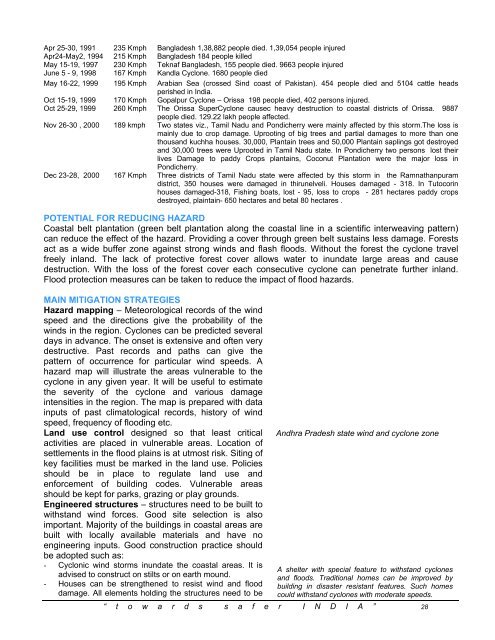Hazards, Disasters And Your Community - United Nations ...
Hazards, Disasters And Your Community - United Nations ...
Hazards, Disasters And Your Community - United Nations ...
Create successful ePaper yourself
Turn your PDF publications into a flip-book with our unique Google optimized e-Paper software.
Apr 25-30, 1991 235 Kmph Bangladesh 1,38,882 people died. 1,39,054 people injured<br />
Apr24-May2, 1994 215 Kmph Bangladesh 184 people killed<br />
May 15-19, 1997 230 Kmph Teknaf Bangladesh, 155 people died. 9663 people injured<br />
June 5 - 9, 1998 167 Kmph Kandla Cyclone. 1680 people died<br />
May 16-22, 1999 195 Kmph Arabian Sea (crossed Sind coast of Pakistan). 454 people died and 5104 cattle heads<br />
perished in India.<br />
Oct 15-19, 1999 170 Kmph Gopalpur Cyclone – Orissa 198 people died, 402 persons injured.<br />
Oct 25-29, 1999 260 Kmph The Orissa SuperCyclone causec heavy destruction to coastal districts of Orissa. 9887<br />
people died. 129.22 lakh people affected.<br />
Nov 26-30 , 2000 189 kmph Two states viz., Tamil Nadu and Pondicherry were mainly affected by this storm.The loss is<br />
mainly due to crop damage. Uprooting of big trees and partial damages to more than one<br />
thousand kuchha houses. 30,000, Plantain trees and 50,000 Plantain saplings got destroyed<br />
and 30,000 trees were Uprooted in Tamil Nadu state. In Pondicherry two persons lost their<br />
lives Damage to paddy Crops plantains, Coconut Plantation were the major loss in<br />
Pondicherry.<br />
Dec 23-28, 2000 167 Kmph Three districts of Tamil Nadu state were affected by this storm in the Ramnathanpuram<br />
district, 350 houses were damaged in thirunelveli. Houses damaged - 318. In Tutocorin<br />
houses damaged-318, Fishing boats, lost - 95, loss to crops - 281 hectares paddy crops<br />
destroyed, plaintain- 650 hectares and betal 80 hectares .<br />
POTENTIAL FOR REDUCING HAZARD<br />
Coastal belt plantation (green belt plantation along the coastal line in a scientific interweaving pattern)<br />
can reduce the effect of the hazard. Providing a cover through green belt sustains less damage. Forests<br />
act as a wide buffer zone against strong winds and flash floods. Without the forest the cyclone travel<br />
freely inland. The lack of protective forest cover allows water to inundate large areas and cause<br />
destruction. With the loss of the forest cover each consecutive cyclone can penetrate further inland.<br />
Flood protection measures can be taken to reduce the impact of flood hazards.<br />
MAIN MITIGATION STRATEGIES<br />
Hazard mapping – Meteorological records of the wind<br />
speed and the directions give the probability of the<br />
winds in the region. Cyclones can be predicted several<br />
days in advance. The onset is extensive and often very<br />
destructive. Past records and paths can give the<br />
pattern of occurrence for particular wind speeds. A<br />
hazard map will illustrate the areas vulnerable to the<br />
cyclone in any given year. It will be useful to estimate<br />
the severity of the cyclone and various damage<br />
intensities in the region. The map is prepared with data<br />
inputs of past climatological records, history of wind<br />
speed, frequency of flooding etc.<br />
Land use control designed so that least critical<br />
activities are placed in vulnerable areas. Location of<br />
settlements in the flood plains is at utmost risk. Siting of<br />
key facilities must be marked in the land use. Policies<br />
should be in place to regulate land use and<br />
enforcement of building codes. Vulnerable areas<br />
should be kept for parks, grazing or play grounds.<br />
Engineered structures – structures need to be built to<br />
withstand wind forces. Good site selection is also<br />
important. Majority of the buildings in coastal areas are<br />
built with locally available materials and have no<br />
engineering inputs. Good construction practice should<br />
be adopted such as:<br />
- Cyclonic wind storms inundate the coastal areas. It is<br />
advised to construct on stilts or on earth mound.<br />
- Houses can be strengthened to resist wind and flood<br />
damage. All elements holding the structures need to be<br />
<strong>And</strong>hra Pradesh state wind and cyclone zone<br />
A shelter with special feature to withstand cyclones<br />
and floods. Traditional homes can be improved by<br />
building in disaster resistant features. Such homes<br />
could withstand cyclones with moderate speeds.<br />
“ t o w a r d s s a f e r I N D I A ” 28

















